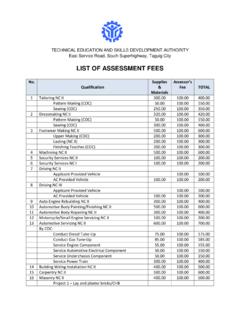Transcription of TRAINING REGULATIONS - Tesda
1 TRAINING REGULATIONS TECHNICAL EDUCATION AND SKILLS DEVELOPMENT AUTHORITY East Service Road, South Superhighway, Taguig City, Metro Manila TRAINERS METHODOLOGY (T M) L EVEL I (Trainer/Assessor) Technical Education and Skills Development Act of 1994 (Republic Act No. 7796) Section 22, Establishment and Administration of the National Trade Skills Standards of the RA 7796 known as the Tesda Act mandates Tesda to establish national occupational skill standards. The Authority shall develop and implement a certification and accreditation program in which private industry group and trade associations are accredited to conduct approved trade tests, and the local government units to promote such trade testing activities in their respective areas in accordance with the guidelines to be set by the Authority.
2 The TRAINING REGULATIONS (TR) serve as basis for the: 1. Competency assessment and certification; 2. Registration and delivery of TRAINING programs; and 3. Development of curriculum and assessment instruments. Each TR has four sections: Section 1 Definition of Qualification - refers to the group of competencies that describes the different functions of the qualification. Section 2 Competency Standards - gives the specifications of competencies required for effective work performance. Section 3 TRAINING Standards - contains information and requirements in designing TRAINING program for certain Qualification.
3 It includes curriculum design, TRAINING delivery; trainee entry requirements; tools equipment and materials; TRAINING facilities; trainer s qualification and institutional assessment . Section 4 National assessment and Certification Arrangement - describes the policies governing assessment and certification procedure. TABLE OF CONTENTS TVET SECTOR TRAINERS METHODOLOGY (TM) L EVEL I Page No. SECTION 1 TRAINERS METHODOLOGY (T M) LEVEL I 1 SECTION 2 COMPETENCY STANDARDS Basic Competencies 2-52 Core Competencies 53-71 SECTION 3 TRAINING STANDARDS Curriculum Design Basic Competencies 72 -74 Core Competencies 75 -76 TRAINING Delivery 77 trainee Entry Requirements 78 List of Tools, Equipment and Materials 78 TRAINING Facilities 79 3.
4 6 Trainers' Qualifications 79 Institutional assessment 79 SECTION 4 NATIONAL assessment AND CERTIFICATION ARRANGEMENTS 80 COMPETENCY MAP 81 DEFINITION OF TERMS 82 TRAINERS METHODOLOGY LEVEL I Re -titled May 201 1 1 TRAINING REGULATIONS FOR TRAINERS METHODOLOGY LEVEL I SECTION 1 TRAINERS METHODOLOGY (T M) L EVEL I The TRAINERS METHODOLOGY LEVEL I consists of competencies a TVET trainer performing functions of trainer and assessor must achieve. A TVET trainer is a person who enables a learner or a group of learners to develop competencies to performing a particular trade or technical work.
5 The Units of Competency comprising this qualification include the following: Code No. BASIC COMPETENCIES 500311109 Lead workplace Communication 500232101 Apply math and science principles in technical TRAINING 500232102 Apply environmental principles and advocate conservation 500232103 Utilize IT applications in technical TRAINING 500311110 Lead small teams 500232104 Apply work ethics, values and quality principles 500232105 Work effectively in vocational education and TRAINING 500232106 Foster and promote a learning culture 500232107 Ensure healthy and safe learning environment 500232108 Maintain and enhance professional practice 500232109 Develop and promote appreciation for cost -benefits of technical TRAINING 500232110 Develop and promote global understanding of labor markets Code No.
6 CORE COMPETENCIES TVT232301 Plan TRAINING sessions TVT232302 Facilitate learning sessions TVT232303 Supervise Work- based learning TVT232304 Conduct competency assessment TVT232305 Maintain TRAINING facilities TVT232306 Utilize electronic media in facilitating TRAINING A person who has achieved this Qualification is competent to be: - TVET Trainer/Technical Trainer - TRAINING Facilitator/Coordinator - Competency Assessor TRAINERS METHODOLOGY LEVEL I Re -titled May 201 1 2 SECTION 2 COMPETENCY STANDARDS This section gives the details of the contents of the core units of competency required for TRAINERS METHODOLOGY (T M) LEVEL I.
7 These units of competency are categorized into basic and core competencies. BASIC COMPETENCIES UNIT OF COMPETENCY : LEAD workplace COMMUNICATION UNIT CODE : 500311109 UNIT DESCRIPTOR : This unit covers the knowledge, skills and attitudes required to lead in the dissemination and discussion of ideas, information and issues in the workplace . Context of this unit : This unit is adopted from the basic competencies for National Certificate Level III. In the context of the Trainers Methodology (T M), the term workplace in this unit would be understood to mean TRAINING /learning environment.
8 ELEMENT PERFORMANCE CRITERIA Italicized terms are elaborated in the Range of Variables 1. Communicate information about workplace processes Appropriate communication method is selected Multiple operations involving several topics areas are communicated accordingly Questions are used to gain extra information Correct sources of information are identified Information is selected and organized correctly Verbal and written reporting is undertaken when required Communication skills are maintained in all situations 2. Lead workplace discussions Response to workplace issues are sought Response to workplace issues are provided immediately Constructive contributions are made to workplace discussions on such issues as production, quality and safety Goals/objectives and action plan undertaken in the workplace are communicated 3.
9 Identify and communicate issues arising in the workplace Issues and problems are identified as they arise Information regarding problems and issues are organized coherently to ensure clear and effective communication Dialogue is initiated with appropriate personnel Communication problems and issues are raised as they arise TRAINERS METHODOLOGY LEVEL I Re -titled May 201 1 3 RANGE OF VARIABLES VARIABLE RANGE 1. Methods of communication Non -verbal gestures Verbal Face to face Two -way radio Speaking to groups Using telephone Written Internet EVIDENCE GUIDE 1.
10 Critical aspects of Competency assessment requires evidence that the candidate: Dealt with a range of communication/information at one time Made constructive contributions in workplace issues Sought workplace issues effectively Responded to workplace issues promptly Presented information clearly and effectively written form Used appropriate sources of information Asked appropriate questions Provided accurate information 2. Underpinning knowledge Organization requirements for written and electronic communication methods Effective verbal communication methods 3.















